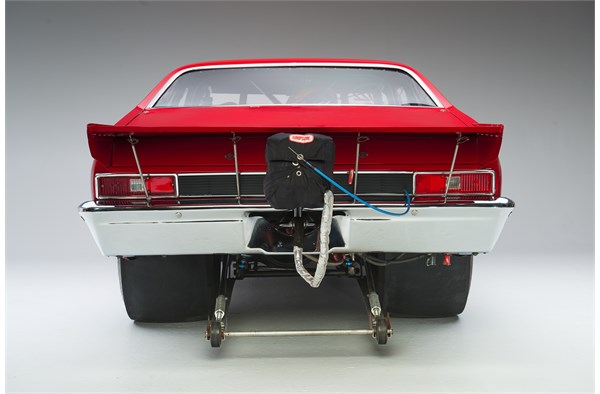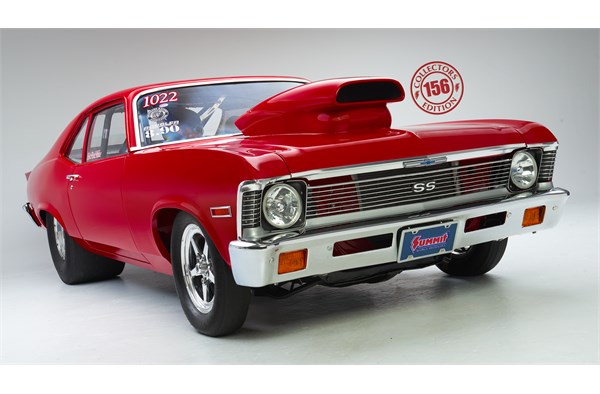Wearing a flawless Vermillion finish over arrow-straight bodywork, it’s easy to mistake “Hot Rod” Mike Pleveich’s 1972 Nova SS for a trailer queen. But when Pleveich loads his excellent X-body onto the trailer, he’s not headed to a car show—he’s going racing.
“I like to go fast,” Pleveich said. And he backs up that fast talk on the dragstrip, one quarter mile at a time.
A member of the Renegade Racing Association (RRA), Pleveich spends most of his summer weekends running an 8.90 index in heads-up competition across Ohio and Pennsylvania. While the Nova looks spectacular standing still, and even better when Mike lights up the massive Hoosier slicks, it needed some serious attention when he bought it.
Over a two-year period, Pleveich replaced most of the exterior sheetmetal. Plus, he swapped the glass for polycarbonate, and runs a Harwood fiberglass hood and trunk lid to save weight.
“Renegade big block tube-chassis cars have to weigh at least 3,200 pounds, but my car has a stock chassis so I can make it as light as possible,” Pleveich said.
Underneath the lightweight hood lurks a brutal 900-horsepower, 540 cubic-inch Reher Morrison racing engine. A Williams 1,150 cfm carburetor feeds the thirsty big block gobs of air and 118-octane race fuel, and that’s just to get the horsepower party started.
“A three-second, 300-horsepower shot of nitrous kicks in one second into the run,” Pleveich said. “That gives the car time to settle in.”
He swaps gears with a Hurst Pistol Grip shifter, while a fully-manual Powerglide transmission sends all of that horsepower to the rear wheels.
“We can’t use air or electric shifters and we’re not allowed to run a delay box,” Pleveich said. “That means you really have to drive the car, and I like that.”
The door slammer’s fully-caged cockpit is all business. An RJS harness keeps Pleveich buckled into a vinyl-upholstered racing seat, while a 10-pound nitrous bottle rides shotgun. A dash-mounted electric fan is the Nova’s only climate control system, and an absolute necessity according to Pleveich.
“I have to wear a full suit and helmet, and the windows don’t open,” he said. “It gets pretty hot in there while I’m waiting to stage.”
Pleveich’s Nova sports aftermarket tubular front control arms and a four-link rear suspension setup, plus Weld Racing AlumaStar wheels on all four corners.
So what’s a race weekend like for Pleveich?
“I stock the motorhome with some food and beverages and put the car on the trailer, usually late Friday night. I like to get an early start on Saturday so I can get a good pit spot on the asphalt, if possible,” he said. “I unload the car and put my three nitrous bottles in the bottle warmer. The warmer keeps the bottles at a consistent temperature. I charge the battery and check the tire pressures. Then I wait to qualify.”
Pleveich races in the RRA’s fastest index class (8.90), where competitors get the same .400-second Pro tree (three yellow lights at once and then green) and try to run an elapsed time close to the index without going faster or “breaking out.”
“The outcome of each race usually comes down to a few thousandths of a second,” Pleveich said. “It’s always extremely close.”
Along the way, Pleveich has learned a thing or two about index racing.
“Consistency is the key,” Pleveich said. “Work on your reaction time but don’t overthink it. I keep a log book and record temperature and humidity data. That way I can know how fast my car will run under any given weather condition. Also, get as much seat time as you can. I was nervous when I first started, now I just want to go faster.”
Each weekend, Pleveich gets a little closer to his first 8.90 class victory, and while there’s often some prize money at stake, he’s not in it for the cash. Like thousands of men and women who race weekend after weekend, he does it for the pure love of the sport, and sense of accomplishment that comes from building and racing your own car.
We think that’s super.
Photography: Todd Biss
FAST SPECS
Chassis
Frame: Stock
Rear End: Strange Ford 9″, 4.29:1 ring and pinion, and axles
Suspension: TRZ Motorsports front control arms, 4-link rear suspension, QA1 front shock absorbers and springs, Afco rear shock absorbers and springs
Steering: Stock, Grant steering wheel
Brakes: Wilwood disc brakes and master cylinder
Wheels and Tires: Weld Racing AlumaStar wheels, Hoosier front tires, Goodyear Eagle slicks
Engine and Transmission
Engine: Reher Morrison Chevy 540, 4340 forged steel crankshaft, Manley H-beam steel connecting rods, Ross Racing pistons, Clevite H-Series rod and main bearings, Erson 7/4 swap camshaft, Dart Pro 1 aluminum cylinder heads, Isky Racing roller lifters, Manley stainless steel valves and titanium retainers, Harland Sharp roller rocker arms
Induction: Williams 1,150 cfm carburetor, Edelbrock Victor intake manifold, MagnaFuel ProStar 500 fuel pump, Switzer Dynamics nitrous oxide system
Ignition and Electrical: MSD Billet distributor, 7AL-2 ignition control, coil, and starter; Moroso ignition wires; Optima RedTop battery
Exhaust: Hooker Super Competition ceramic-coated headers
Transmission: Abruzzi GM Powerglide transmission and 4,500 rpm stall speed torque converter, Pro Brake transbrake, Hurst Pistol Grip shifter
Other Items: Moroso vacuum pump, Meziere electric water pump, aluminum radiator
Exterior
Body: 1972 Chevy Nova SS
Paint: 2008 Ford Vermillion Red
Bodywork By: Owner and Like New Auto Body
Paint By: Like New Auto Body
Other Items: Harwood fiberglass hood, hood scoop, and trunk lid; polycarbonate windows; aluminum wing; Simpson parachute; Competition Engineering wheelie bars
Interior
Upholstery: Plastic race seat with vinyl cover, black carpet
Other Items: Full roll cage, RJS harness and window net, Auto Meter Pro-Comp gauges, electric fan
Special Thanks To: My wife, Jeff Petrosky, Brian Tiffy, Matthew Pleveich, Ed Kasicki













Comments